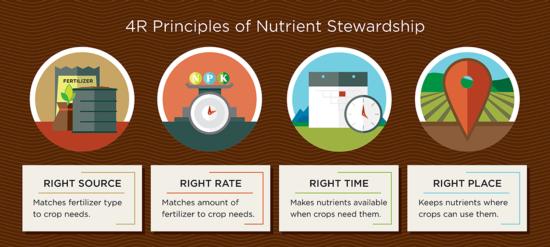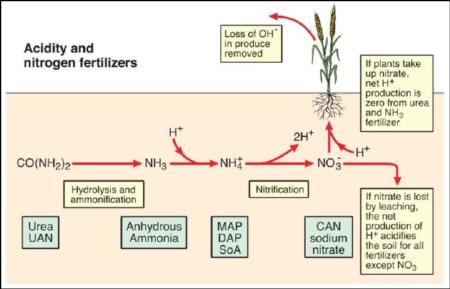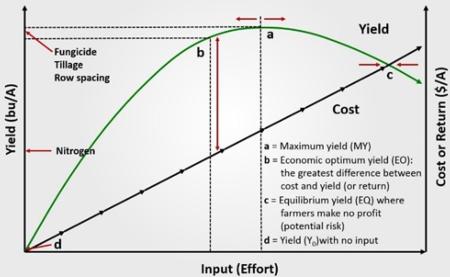Fertilizer Nitrogen

Consult this summary of practices to address these four Rs.
For crop specific fertilizer recommendations, visit the California Fertilization Guidelines from the CDFA.
Right Product/Source

In addition to choosing the right form, it is important to choose your fertilizers in the correct proportions. For example, additional N fertilizer will produce no increases in yield if P, K, or other micronutrients are deficient.
Right Rate
One of the most difficult decisions around N fertilizer management is the correct rate. This difficulty arises out of the myriad of factors that affect fertilizer availability: soil texture, soil mineralogy, organic matter content, season, and crop, to name a few. The variation among even these few variables makes choosing a correct fertilizer rate difficult, although ranges have been developed for certain crops2. To calibrate your field-specific “right rate”, it is helpful to utilize a combination of rate trials, pre-plant soil tests, and in-season plant tissue analyses (e.g. petiole tests, remote sensing, etc.)3. For more crop-specific measures for NPK recommendations, you can use CDFA’s California Fertilization Guidelines. It is also helpful to keep records from year to year, to get to know how your fertilizer applications are relating to crop yields over time. The end-of-season corn stalk nitrate test can help evaluate your nitrogen management practices if you are producing grain or silage corn.

Right Time
To increase the efficiency for fertilizer applications, it is necessary to synchronize fertilizer release with plant demand. This can generally be achieved by either splitting fertilizer applications throughout the season and/or the use of stabilized fertilizers.
- Split Application: Split application of fertilizer N has shown to be effective for a wide variety of California field crops8,9,10,11,12,13,14 and tree crops15,16,17,18. In fertigated systems, these split applications are especially effective since they can react to in-season changes in soil N status.
- Stabilized Fertilizers: Another method to optimize N release with crop N uptake is through the use of stabilized fertilizers,which are classified as either nitrification inhibitors orurease inhibitors.
- Nitrification Inhibitors will slow the conversion of fertilizer ammonia or ammonium to nitrate, which is easily leached. This retains fertilizer N within the rooting zone, increasing the nitrogen use efficiency by upwards of 15%19,20 and increasing yields by about 5%20.
- Urease inhibitors slow the conversion of urea into ammonia in moist conditions, which can then be lost through volatilization. Similar to nitrification inhibitors, urease inhibitors have been shown to increase nitrogen use efficiency and yields by upwards of 10%20.
For both types of stabilized fertilizers, these effects become more pronounced as the soil texture becomes coarser/more sandy due to the higher susceptibility to leaching in these textures20. In addition to increased efficiency and productivity, the use of these stabilized fertilizers also has led to increased air and water quality21.
Right Place
“Right place” can refer to two different aspects of fertilizer placement: placement within the soil profile and placement within a field.
- Within Soil Profile: Placement of fertilizers within the soil profile generally pertains to placing the nutrients close to the rooting zone. This is especially important for less mobile nutrients, like phosphorus and potassium, but less so for nitrogen. A discussion of “right placement” for P and K can be read here. Oftentimes, the placement of a nitrogen-based fertilizer is influenced by the form of fertilizer being applied, resulting in many effective combinations. However, several important considerations when choosing your fertilizer source and placement are: gaseous losses when using ammonia (aqua or anhydrous) or urea, and leaching susceptibility in nitrate-containing fertilizers.
- Within a Field: The placement of fertilizers within a field will contribute strongly to nutrient use efficiency. In-field variability in soil texture, soil type, or organic matter content will change the “right rate”, so the distribution of fertilizer within a field is important to consider. Use of a single, uniform rate across a field is likely to underfertilize in some areas and overfertilize in others22. Variable rate fertilization has been shown to increase profitability in corn23,24, especially in fields with high variability and/or high innate fertility25. The effectiveness of variable rate fertilization increases when it is coupled with other measurements, such as canopy reflectance26,27.
References
1. Fertilizer Technology Research Center. (2013). Fertilizers and Soil Acidity. http://www.cropnutrition.com/fertilizers-and-soil-acidity. Accessed March 14, 2016.
2. Rosenstock, T., Liptzin, D., Six, J., & Tomich, T. (2013). Nitrogen fertilizer use in California: Assessing the data, trends and a way forward. California agriculture, 67(1), 68-79.
3. Phillips, S. B., Camberato, J. J., & Leikam, D. (2009). Selecting the right fertilizer rate: A component of 4R nutrient stewardship. Crops & Soils, 42(4), 14-18.
4. Lauer, J. (2015). Do We Grow Another Bushel or Save a Buck? No-Till Farmer. http://www.no-tillfarmer.com/articles/4393-do-we-grow-another-bushel-or-save-a-buck. Accessed March 14, 2016.
5. Scharf, P. C., Kitchen, N. R., Sudduth, K. A., Davis, J. G., Hubbard, V. C., & Lory, J. A. (2005). Field-scale variability in optimal nitrogen fertilizer rate for corn. Agronomy Journal, 97(2), 452-461.
6. Scharf, P. C., Kitchen, N. R., Sudduth, K. A., & Davis, J. G. (2006). Spatially variable corn yield is a weak predictor of optimal nitrogen rate. Soil Science Society of America Journal, 70(6), 2154-2160.
7. Hong, N., Scharf, P. C., Davis, J. G., Kitchen, N. R., & Sudduth, K. A. (2007). Economically optimal nitrogen rate reduces soil residual nitrate. Journal of environmental quality, 36(2), 354-362.
8. Welch, N., Tyler, K. B., Ririe, D., & Broadbent, F. (1983). Lettuce efficiency in using fertilizer nitrogen. California Agriculture, 37(11), 18-19.
9. Welch, N., Tyler, K., & Ririe, D. (1987). Split nitrogen applications best for cauliflower. California Agriculture, 41(11), 21-22.
10. Henson, R. A., & Bliss, F. A. (1991). Effects of N fertilizer application timing on common bean production. Fertilizer research, 29(2), 133-138.
11. LeStrange, M., Mitchell, J.P., Jackson, L.E. (1995). Determination of Best Nitrogen Management Practices for Broccoli Production in the San Joaquin Valley. Fertilizer Research and Education Program Report.
12. Hutmacher, B. (2012). California Cotton: Split or Don’t Split Nitrogen? Field Check Cotton Newsletter. UCCE.
13. Bottoms, T. G., Hartz, T. K., Cahn, M. D., & Farrara, B. F. (2013). Crop and soil nitrogen dynamics in annual strawberry production in California. HortScience, 48(8), 1034-1039.
14. Orloff, S., Wright, S., Wilson, R. (2013). Effect of Nitrogen Fertilization Practices on Spring Wheat Yield and Protein Content. California Wheat Commission: Interim Report.
15. Richardson, W., & Meyer, R. (1990). Spring and summer nitrogen applications to Vina walnuts. California Agriculture, 44(4), 30-32.
16. Peacock, B., Christensen, P., Hirschfelt, D. (1998). Best Management Practices for Nitrogen Fertilization of Grapevines. Tulare County UCCE. Pub NG4-96.
17. Bender, G. S., & Faber, B. (1999). Avocado fertilization. University California Cooperative Extension. San Diego, CA.
18. Kallsen, C. (2003). Spring best time to fertilize citrus. Western Farm Press. April 19, 2003.
19. Smith, R. (2013). Nitrogen Fertilizer Technology Evaluations and Nitrogen Uptake by Vegetables. Irrigation Nutrient Management Meeting, 2013. http://cemonterey.ucanr.edu/files/162229.pdf
20. Abalos, D., Jeffery, S., Sanz-Cobena, A., Guardia, G., & Vallejo, A. (2014). Meta-analysis of the effect of urease and nitrification inhibitors on crop productivity and nitrogen use efficiency. Agriculture, Ecosystems & Environment, 189, 136-144.
21. Shoji, S., Delgado, J., Mosier, A., & Miura, Y. (2001). Use of controlled release fertilizers and nitrification inhibitors to increase nitrogen use efficiency and to conserve air andwater quality. Communications in Soil Science and Plant Analysis, 32(7-8), 1051-1070.
22. Phillips, S. (2010). The Role of Spatial Variability in Nutrient Management. International Plant Nutrition Institute. https://www.ipni.net/ppiweb/bcrops.nsf/$webindex/B24F8BAE678DA8648525778C0064A4C9/$file/BC-2010-3-Page-32.pdf
23. Babcock, B. A., & Pautsch, G. R. (1998). Moving from uniform to variable fertilizer rates on Iowa corn: Effects on rates and returns. Journal of Agricultural and Resource Economics, 385-400.
24. Basso, B., Dumont, B., Cammarano, D., Pezzuolo, A., Marinello, F., & Sartori, L. (2016). Environmental and economic benefits of variable rate nitrogen fertilization in a nitrate vulnerable zone. Science of the Total Environment, 545, 227-235.
25. Thrikawala, S., Weersink, A., Fox, G., & Kachanoski, G. (1999). Economic feasibility of variable-rate technology for nitrogen on corn. American Journal of Agricultural Economics, 81(4), 914-927.
26. Kitchen, N. R., Sudduth, K. A., Drummond, S. T., Scharf, P. C., Palm, H. L., Roberts, D. F., & Vories, E. D. (2010). Ground-based canopy reflectance sensing for variable-rate nitrogen corn fertilization. Agronomy Journal, 102(1), 71-84.
27. Boyer, C. N., Brorsen, B. W., Solie, J. B., & Raun, W. R. (2011). Profitability of variable rate nitrogen application in wheat production. Precision Agriculture, 12(4), 473-487.
